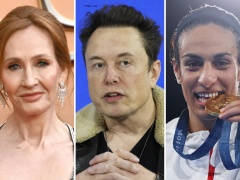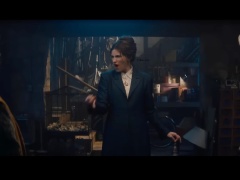
If viewers are looking for an easy watch, it’s not “Stolen Youth: Inside the Cult at Sarah Lawrence.” And that’s the whole point. The three-part Hulu docuseries, directed by Zach Heinzerling, dives into the emotional and physical torture that students endured at the hands of conman Larry Ray.
Ray was arrested in 2020, one year after New York Magazine published “The Stolen Kids of Sarah Lawrence,” an investigation into the abuse inflicted on multiple students and friends of his daughter, Talia Ray. Last month, Ray was sentenced to 60 years in prison for racketeering, extortion, sex trafficking, forced labor, tax evasion and money laundering offenses.
The docuseries, now streaming on Hulu, traces the cult’s 2010 origins on the Sarah Lawrence campus. It includes original footage of the abuse, as well as first-hand accounts from the survivors. Here, Heinzerling breaks down the process of obtaining footage from (and interviewing) Ray, speaking with the survivors as they attempted to move forward —and finding closure for the victims.
Let’s go back to the beginning. How did you get started with this doc?
Daniel Levin was one of the sources of the New York Magazine article. He started writing a book about his experience with Larry, and he thought it would be interesting to make a documentary. There was already talk of a big Hollywood remake, and Daniel felt like he wanted to find someone to make something from the perspective of the survivors. And to protect the victims in the process. That was his initial pitch to me — someone’s gonna make this, and I want to make it in a way that would be helpful for the world, and allow people to understand our story at a more human level. From there, I started reaching out to other victims.
When was that?
The first conversations were in the fall of 2019. It wasn’t until 2020 when Larry was indicted, and I started speaking with Felicia [Rosario] and Isabella [Pollok], that I became aware of their situation. It really wasn’t until 2022 when the trial happened that the fuller picture came into place. We had access to the archival introduced in the trial, and the Rosarios were reunited. So, it was kind of a three-year process, but incited by the article and Daniel’s first contact with me.
Let’s talk about all of this footage. There’s so many videos and audio files. How did you get access to those?
I talked to Larry before he was indicted, and he actually emailed me audio clips of what he considered to be evidence of his innocence— when, to anyone who was somewhat privy to this story, knew that these were the exact opposite. These were more or less interrogation sessions. So, the first archival I got was actually from Larry himself. Subsequent to that, Felicia started to share archival that she had. Then it wasn’t really until the trial that the majority of the videos and a lot more audio evidence came into our possession. It was made public when it was introduced at Larry’s trial, and then we had time to go through it and use it in the documentary. Of course, the irony being that all of this material he recorded to prove his innocence and prove that he was a victim of this conspiracy — all of that material was used to convict him of multiple federal crimes that resulted in him being in prison for the rest of his life.

The videos are difficult to watch, but even more chilling is watching Felicia’s changes — her being completely on his side, then slowly realizing her memories aren’t even her own. Can you talk about how that process was?
Yeah, when I first met her, she was still defending Larry, and part of the reason that she was talking to me was because she wanted to let the public know that Larry has essentially saved her life. Both Isabella and Felicia participated in the New York Magazine article for the same reason. I knew that with time and with separation from Larry — and with each of them having some kind of support system — that maybe they would eventually get to a place where they could see Larry as their abuser. I didn’t have any idea that it would happen. I didn’t have any preconceived notion that it could happen while we were still making the documentary. I think everyone in the situation has their own path. I talked a lot with Dan Shaw and Dr. Rachel Bernstein, both of whom are cult specialists, about this process. Mostly, it’s about meeting people where they are and offering unconditional support.
For Felicia, once Larry was no longer a direct threat, she started to be able to think on her own. I would say it was about a year from when Larry was indicted, and taken to holding where he waited trial, until Felicia started to show me that she was seeing him differently. She was reading books, she was talking to a therapist, she had legal counsel that was, I’m sure, helping her. But she really took it upon herself to try to go through what was an extremely challenging process of differentiating what memories in her life were manipulated by Larry and which were real. It’s a process that takes a lot of effort and courage.
How was that for you to see?
I would say it was kind of the best aspect of this project. In a project so full of really, really disturbing, dramatic and personally affecting material, to witness somebody whose life had been stolen from them, whose family’s lives had been destroyed, rebuild that and reunite with her family who she hadn’t seen in upwards of 10 years, was miraculous. It felt like a miracle, seeing how far she had gone. It became a snowball effect with her, then her reaching out to her siblings — who I had spoken with, but who weren’t really comfortable being with family members, because of all of that built-in trauma that existed in between them. I think Felicia really sparked an interest in them to reignite the relationship that they had with their parents, and with each other. That family is amazing. I can’t imagine losing all three of your children and basically your livelihood to a person who was the dad of your son’s girlfriend in college, who completely destroyed their life. You see that they are talking again, but you know that period is lost forever, and the damage that was done is everlasting.
It was such a relief to see that family come back together — and be able to sit and have a meal together — after seeing how devastated the parents were in the beginning.
I tried to avoid it feeling like a happy ending. I feel like it was such a relief from most of the story, which was so horrible, to see something potentially positive that came out of this experience for them. But it doesn’t at all mitigate the damage that Larry did. It’s tricky in these kinds of projects, figuring out what the right balance is because you want an audience to be able to watch a story. You also want it to hold integrity and be honest, but the depth of abuse and depravity and just, quite frankly, sickening nature of the material, made that really hard. I will say that there’s a lot of abuses that were outlined in the trial that we didn’t cover in our documentary, merely because it would become gratuitous. It becomes too hard to bear. People may feel that about the documentary. We tried to share enough to help you understand the depths of the prison that they were in, and also, so that you could really feel how miraculous the journey out was for Felicia. It was definitely very hard material to deal with.

In the same way that we see Felicia come out of this, we see Isabella still in it, and still believing him long after his indictment. How was the process of working with her and remaining supportive?
I was meeting with Dr. Bernstein each week through the process and just listening. I think the process of having a non-judgmental listener is a lot of the times what happens in therapy. I’m not a cult expert and I’m not a therapist, so mostly, I was listening. Everyone goes through this process at their own pace. When I was in contact, she had been under Larry’s influence for so long, and her situation is quite different from Felicia’s. I tried to underline aspects of that, and see her for the more complete person than she is publicly. She’s been labeled his “lieutenant,” the “Ghislaine Maxwell” figure, if we were to compare it to other similar stories. But I see her as a victim, and there’s been recent court filings that indicate that she’s now seeing Larry as as her abuser. I can’t speak for her or where she is. Her situation is different, and it changed legally when she pled guilty [to a single count of conspiracy], so our communication changed. I know that she has support, and I’m very optimistic about her. I’m hoping that she’ll also be able to move on with her life like the other victims have been trying to do.
One person we didn’t get a resolution on is Talia Ray, Larry’s daughter. Have there been any developments there?
She declined to participate. It’s not really much more to that right now. I imagine she’s probably going through a lot. I can’t speak for her, but I can’t imagine having Larry as your father presents its own challenges. I hope that she has support through all this as well.
You had contact with Larry Ray before the indictment. If he decided he wanted to talk, would you be interested in granting him an audience?
Not really. I found that when I spoke with Larry, he was just reciting the same “I’m a victim” sob story that he had told his daughter and the group of students at Sarah Lawrence when he arrived on campus. Of course, they didn’t have the insight that I have. It kind of just falls on deaf ears, and I feel like he’s in such a delusional state of denial that the denial is his reality. I don’t know that anything he says gives us any insight into how this happened, or who he is as a person, because it’s all lies. I think there’d be more insight gained from speaking to credible sources from his childhood. But, for the purpose of our documentary, no one would really speak to us. I think those people would be Larry’s brother or Larry’s ex-wife, but they all declined to participate. From Larry himself, I think you know exactly what you’re gonna get: I’m a victim. There’s zero remorse, zero insight, zero truth, zero analysis of the situation.
Interviewing Larry is like listening to all the archival — it’s what happened to Larry, it’s that these individuals who he abused were asking for help and that he was helping them. That’s basically the depth of his story, so it didn’t feel particularly insightful or relevant. I actually had some footage and audio interviews, but it just never really seemed all that important in this project.
Would you be interested in revisiting this story with another angle and telling another chapter?
I think I’d be open to doing more. It’s always hard as a filmmaker when you have to “kill your darlings” in the edit. In this process, there’s so much to Larry’s story, and there is so much more to who Larry is. There’s questions about other people that were involved and how they dealt with this. So I wouldn’t necessarily close the book. Hopefully, this series brings up some conversations amongst the people that declined to participate, and maybe they want to share their stories.
All three episodes of “Stolen Youth: Inside the Cult at Sarah Lawrence” are now streaming on Hulu.






